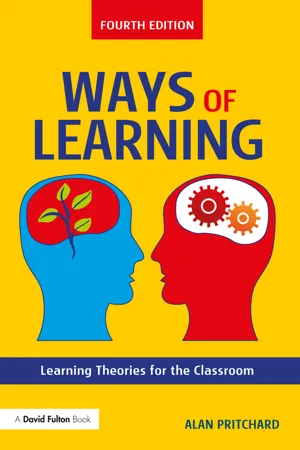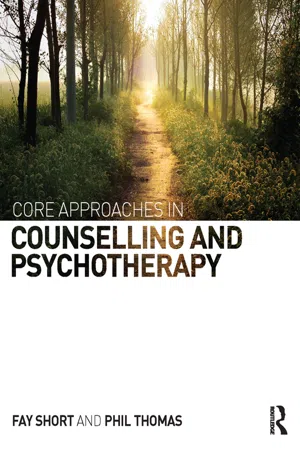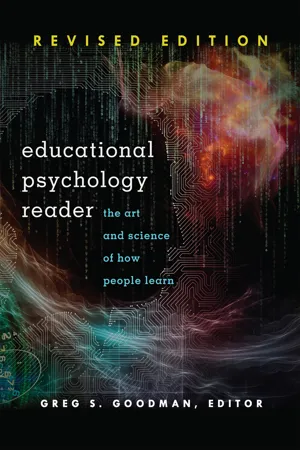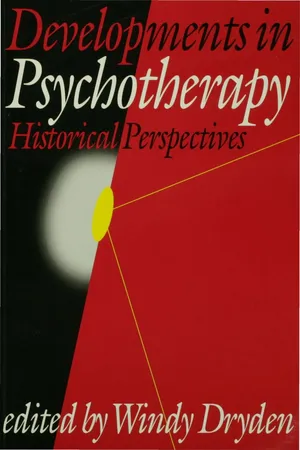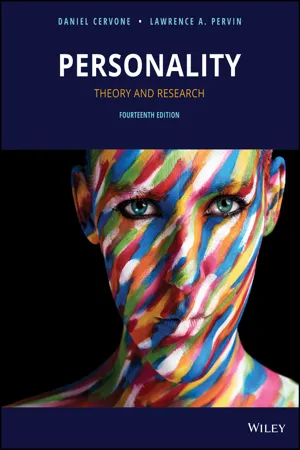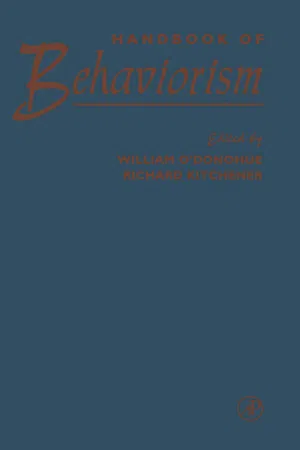Psychology
Behaviourism
Behaviourism is a psychological theory that focuses on observable behaviors rather than internal mental processes. It emphasizes the role of the environment in shaping and controlling behavior through conditioning and reinforcement. Behaviourists believe that behavior can be studied scientifically and that learning is the result of associations between stimuli and responses.
Written by Perlego with AI-assistance
Related key terms
1 of 5
11 Key excerpts on "Behaviourism"
- eBook - ePub
Ways of Learning
Learning Theories for the Classroom
- Alan Pritchard(Author)
- 2017(Publication Date)
- Routledge(Publisher)
2 Behaviourism and the beginnings of theoryThe ideas of Behaviourism have their roots in the late nineteenth and early twentieth centuries, although it is possible to trace some ideas back to Thomas Hobbes (1588–1679) and David Hume (1711–76). John Watson (1878–1958), an American working in the realm of this new philosophy of psychology, is widely accepted as one of the earliest proponents of Behaviourism. He is believed to have first used the term ‘Behaviourism’ (though he probably used the American spelling). Watson came to the view that psychology could only ever become a true science if it became a process of detailed objective observation and scientific measurement. This notion of observation and measurement became central to the work of behaviourists. Any consideration of mental process, which is by definition unobservable, fell outside their self-imposed range of interest. So, behaviourist approaches to and explanations of learning developed out of the study of what can actually be seen. As we will see, this approach to developing a psychological theory of learning ignores much of the hidden mental process that later workers in the field have come to explain and to hold as crucially important to our understanding of the complex activity that makes up different types of learning. Advances in neuroimaging techniques, as we will see later, make this an even more important element of any work investigating learning.Behaviourism is based around the central notion of a response being made to a particular stimulus. This apparently simple relationship has been used to describe even the most complex learning situations. At its simplest, we can observe behaviour, which we can refer to as ‘learnt behaviour’, in a wide range of diverse situations. For example, a performing seal will respond to a particular stimulus – the sound of a hooter or the presentation of a fish – by raising itself up and slapping its flippers together as if clapping. A pet dog will respond to the stimulus of the spoken word, ‘Beg’, by doing just that, much to the delight of onlookers. - eBook - PDF
Psychology
Six Perspectives
- Dodge Fernald(Author)
- 2007(Publication Date)
- SAGE Publications, Inc(Publisher)
This analogy facilitated explanations of human beings—up to a point—and it fostered a practical outlook compatible with behaviorism. Two streams of later thought contributed markedly to the rise of behav-iorism. Evolutionary theory in biology stressed the role of the environment in shaping the physical structure of organisms over the millennia. According to behaviorism, the environment plays a similar role in shaping the behavior of any species over the millennia, as well as the behavior of an individual over his or her lifetime. Behavior is selected or molded by its antecedents and consequences in the environment. The other stream, operationism in philosophy, emphasizes that the only concepts suitable for scientific study are those defined by the operations for 132 —— Psychology: Six Perspectives measuring them. The precision in operational definitions appealed to behav-iorists, and their use spread throughout psychology, contributing to behav-iorism’s eminence in the field. Conditioning as Learning In some respects, behaviorism began in the United States in 1913 with a call to arms by the colorful and controversial John B. Watson, who pub-lished a paper entitled Psychology as the Behaviorist Views It. He rebelled against introspection and other studies of consciousness from Wundt’s lab-oratory, arguing that psychology should abandon all introspective efforts to examine the mind, which is observable only by the experiencing individual. His approach, called methodological behaviorism ¸ rejected the study of any events that could not be investigated by the more objective methods of the natural sciences. Like physics, physiology, and other natural sciences, Watson argued that psychology should study publicly observable events, not mental activities, whatever they may be. But not long after his dramatic protest, Watson left the field, his university, and academia altogether, all on a scandalous basis—at least in those days. - eBook - PDF
- Roxana Moreno(Author)
- 2011(Publication Date)
- Wiley(Publisher)
This method and assumption, however, have been strongly criticized. We discuss the limitations of Learning Any relatively permanent change in our thoughts, feelings, or behavior that results from experience. Behaviorism A perspective that psychology should be concerned with the study of human behavior rather than with the study of the human mind. Classical Conditioning •••••••••••••••••• 157 C behaviorist theories in more detail when we introduce cognitive theories of learning in the following chapter. Once you understand how behaviorist principles work, you can apply them effec- tively in your classroom—and you’ll find many examples in this chapter on how to use behavioral principles in your classroom. Because the focus of behavioral views of learn- ing is on producing desirable behaviors or reducing undesirable behaviors, behavioral principles are most effective in classroom management (Kazden, 2001; Martin & Pear, 2002). The careful use of behavioral learning techniques can help teachers address stu- dents’ misbehavior and social skill deficits (Bergan & Caldwell, 1995). Behavioral principles can be applied whenever a teacher is interested in promot- ing appropriate behaviors (i.e., taking turns, doing homework), skills (i.e., social, motor), or self-regulation (i.e., self-monitoring, self-evaluating), and discouraging inap- propriate behaviors (i.e., cheating, lying, fighting). Let’s examine the first theory of behaviorism, known as classical conditioning. This theory looks at the automatic responses we have. For example, if someone pinches your arm, you will probably pull your arm away. How does this type of conditioning apply to the classroom? Keep reading and you’ll find out! Later in the chapter we look at the behaviorist view of learning called operant con- ditioning. Operant conditioning means that we can set something up in the environ- ment that a person will respond to. A teacher may give a student a gold star for working quietly at her desk. - eBook - PDF
Early Childhood Studies
A Social Science Perspective
- Ewan Ingleby(Author)
- 2012(Publication Date)
- Bloomsbury Academic(Publisher)
The key learning process is known as ‘conditioning’. Humanism The individual is seen as being unique, rational and self-determining. Present experience is held to be as important as past experience. Psychodynamic theory The mind is seen as being a combination of conscious thoughts and the workings of the unconscious mind. The unconscious mind expresses itself through dreams and behaviour we are not consciously aware of. Cognitive theory This perspective looks at what happens after a stimulus but before a response. The human mind is likened to a computer. People are seen as information processors, selecting, coding, storing and retrieving information when needed. Neurobiological theory Behaviour is considered as being determined by genetic, physiological and neurobiological factors and processes. Early Childhood Studies 10 he becomes. The Jesuit notion of ‘giving me the boy and I’ll show you the man’ equates to this idea. This suggests that we become who we are as a result of factors beyond and outside individuals. A number of psychologists have become famous members of the behav-iourist school of thought. Burrhus Skinner, Edward Thorndike, John Watson and Ivan Pavlov have become synonymous with behaviourist psychology. All of these psychologists share in common the belief that external factors are of critical importance in producing thoughts and behaviour. The terms ‘classical conditioning’ and ‘operant conditioning’ are partic-ularly important within Behaviourism. Classical conditioning is associated with the work of Ivan Pavlov. It has become associated with the ways whereby biological responses are regulated by external factors. This produces what has become phrased as a ‘conditioned response’ where a form of behaviour occurs in association with a particular stimulus. Operant conditioning is a term that has become associated with the work of Burrhus Skinner. - eBook - ePub
- Fay Short, Phil Thomas(Authors)
- 2014(Publication Date)
- Routledge(Publisher)
Psychology was initially defined as the study of the human mind and linked to work in medicine and philosophyHowever, animal research in the early 1900s produced results that could be generalised to human behaviour (Thorndike, 1898; Pavlov, 1928) This led to psychology being redefined as the study of human behaviourTabula rasa Behavioural approach focuses exclusively on observable and measurable behaviour Emphasises the importance of nurtureHumans are born as a tabula rasa or blank slate on which experience writes the patterns of their future behaviourMajor advances in the behavioural approach
Initial interest in the behavioural approach
Thorndike identified the Law of Effect in 1898 Proposed that behaviour can be predicted and controlled according to consequences ‘Animal intelligence: an experimental study of the associative processes in animals’ published in 1898 Pavlov presented at the International Medical Congress in Madrid in 1903 Reported physiological research revealing a system of conditioning to explain human behaviour Introduced the idea that psychological processes can be studied scientificallyLectures on Conditioned Reflexes: Twenty-Five Years of Objective Study of the Higher Nervous Activity Behavior of Animals published in 1928Formal establishment of behavioural approach
Watson published the Behaviorist Manifesto in 1913 Foundation of the behavioural approach ‘Psychology as the behaviorist views it’ published in 1913 Skinner introduced the concept of behaviour shaping through operant conditioning in 1938 - eBook - ePub
Understanding Crisis Therapies
An Integrative Approach to Crisis Intervention and Post Traumatic Stress
- Hilda Loughran(Author)
- 2011(Publication Date)
- Jessica Kingsley Publishers(Publisher)
Chapter 4
A Behavioural Approach
A brief history of behaviour theory
Miller (2002) outlines the dissatisfaction within psychology because of what Watson in 1913 saw as lack of systematic and scientific study. Watson according to Miller (2002) declared that the goal of psychology should be to predict and control overt behaviour. The 1920s saw the establishment of a ‘Behaviourism’ stream in psychology. This was solidly based on a ‘scientific’ psychology and influenced by Watson’s 1924 research and theoretical formulations and the laboratory studies published in 1928 by Pavlov (Miller 2002). This shift in focus emphasised the need to understand behaviour in a way that was observable and measurable.Pavlov’s work caught the imagination of generations of psychology students. His study of dogs’ reaction to stimuli (Pavlov’s dogs) is probably one of the most widely known pieces of behavioural research. His research into the behaviour of dogs was allied to human behaviour and in conjunction with Watson and Rayners’ 1920s work became the foundation of a way of explaining human behaviour known as classical conditioning .So theories about behaviour have been around a long time but therapeutic applications based on these theories are a somewhat more recent development. Bellack and Hersen (1985) in tracking the development of behaviour therapy commented that ‘the period between 1920 and 1950 saw an unmarked progress in the understanding of conditioning and learning’ (p.4). They suggested that it was not until the late 1950s and early 1960s that behaviour therapy as a discipline really began. The theoretical framework underpinning this behaviour therapy was according to Bellack and Hersen (1985) learning theory, specifically the principles of classical and operant conditioning.The connection between learning theory and behaviour therapy was central to Eysenck’s 1964 definition of behaviour therapy. Writers such as Yates (1975) disagree about this relationship between learning theory and behaviour therapy. Yates (1975) in defining behaviour therapy emphasised that although learning theory may have a role in many behaviour disorders, learning theory is not the essence of behaviour therapy as Eysenck claimed. Reid (2004) in his discussion of operant behaviour theory suggests that classical and operant conditioning along with theories about learning and modelling behaviour ‘formed what is known as learning theory, the foundation of behaviour therapy’ (p.36). - eBook - PDF
Educational Psychology Reader
The Art and Science of How People Learn - Revised Edition
- Greg S. Goodman(Author)
- 2013(Publication Date)
SECTION II Behaviorism Behaviorism has had a profound impact in a number of disciplines including psychology, clinical ther- apy, educational research, and instructional design (Driscoll, 2005). As the first theory that was applied directly to educational settings to facilitate teaching, behaviorism is an extremely important theory in the education field. It was the most dominant theory in American educational psychology between the 1920s and the 1960s and still has tremendous impact on educational practices today. However, behaviorism has been criticized by many researchers, teachers, administrators, and policy- makers. The purpose of this chapter is threefold: 1) to develop a correct understanding of behavior- ism, 2) to objectively and critically evaluate its effect on learning, and 3) to provide practical guidelines on its applications in school settings. This chapter is divided into two sections. The first provides an overview of behaviorism, e.g., its history and some key concepts. The second broadly evaluates its effects, both positive and nega- tive, on education. The second part also includes practical guidelines on the applications of behav- iorism in actual school and classroom environments. It is my sincere hope that this chapter will help the readers not only develop a deep understanding of behaviorism but also walk away with practi- cal strategies and methods. OVERVIEW OF BEHAVIORISM CLASSICAL CONDITIONING BY PAVLOV Behaviorism began with the Russian psychologist Pavlov and his famous dog salivation experiment in the 1890s. In his experiment, Pavlov and his laboratory staff first presented food to the dog and found that the dog actually started the act of salivating before eating the food. When an actual stimulus itself (e.g., food) causes some action in animals or humans, the stimulus is called an unconditioned stimulus. Inspired by this discovery, Pavlov and his staff designed another experiment. - eBook - PDF
Developments in Psychotherapy
Historical Perspectives
- Windy Dryden(Author)
- 1996(Publication Date)
- SAGE Publications Ltd(Publisher)
In this way, behaviour therapists share with behavioural psychologists from non-clinical fields an emphasis on overt behaviour. As wel l as this emphasis, behaviour therapists have taken from academic psychology an insistence on rigorous evaluation of their interventions and many of the investigation methods used in behavioural psychology. Indeed, in an examination of the meaning of being a behaviour therapist, Thoresen and Coates (1978) note the strong identification of the therapy with scientific principles and methods. They examine five complementary definitions of behaviour therapy: applied learning theory, application of results and methods of experimental behavioural science , experimental study of change 168 Developments in Psychotherapy processes, controlled experimental studies of the single case, and technical eclecticism. Whilst each of these definit ions has excited controversy during the history of behaviour therapy, they all site behaviour therapy clearly within the tradi tion of empiric ism. Thoresen and Coates conclude by suggesting that therapy is best practised and evaluated within this scient ific tradition, and characterize the behaviour therapis t as one who challenges the non-scientific myths of other therapeutic tradit ions. At its best, behaviour therapy is, therefore, 'scientific ', in this broad sense of subjecting the therapeutic process to empir ical tes ting. Behaviour therapis ts seek to engage clients as partic ipants in therapeu tic 'experiments ', which at tempt to establish the relevance of conditioning theories to clients' difficult ies. Therapy is also eclectic, drawing on many techniques, challeng-ing of orthodoxy, humanistic (since it seeks to assert the individuality of clients' experiences and difficulties, rather than to ascribe to them mental 'illnesses ' which different iate them from the rest of the population), pragmatic, and driven princ ipally by technique rather than relationsh ip. - eBook - PDF
Personality
Theory and Research
- Daniel Cervone, Lawrence A. Pervin(Authors)
- 2018(Publication Date)
- Wiley(Publisher)
This is the strategy adopted by the behaviorist. Table 10.1 summarizes the basic points of emphasis in behaviorism that we have reviewed. With this background, we now begin our coverage of theories that were developed within this behavioral approach to psychological science. Specifically, we start where the approach itself began histori- cally, with the ideas of John Watson and the associated research contributions of Ivan Pavlov. Watson, Pavlov, and Classical Conditioning Watson’s Behaviorism John B. Watson (1878–1958) was the founder of the approach to psychology known as behavior- ism. He began his graduate study at the University of Chicago in philosophy and then switched to psychology. He took courses in neurology and physiology and began to do biological research with animals. During the year before he received his doctorate, Watson had an emotional break- down and had sleepless nights for many weeks. He described this period as causing him to become interested in the work of Freud (Watson, 1936, p. 274). He eventually completed his dis- sertation, which caused him to develop a particular attitude regarding the use of human subjects: At Chicago, I first began a tentative formulation of my later point of view. I never wanted to use human subjects. I hated to serve as a subject. I didn’t like the stuffy, artificial instructions given to subjects. I always was uncomfortable and acted unnaturally. With animals I was at home. I felt that, in studying Table 10.1 Basic Points of Emphasis of Learning Approaches to Personality 1. Empirical research is the cornerstone of theory and practice 2. Personality theory and applied practice should be based on principles of learning 3. Behavior is responsive to reinforcement variables in the environment and is more situation specific than suggested by other personality theories (e.g., trait, psychoanalytic) 4. - eBook - PDF
- William O'Donohue, Richard Kitchener(Authors)
- 1998(Publication Date)
- Academic Press(Publisher)
Finally, there is an applied as-pect to certain kinds of behaviorism : behavior modification, child raising tech-niques, educational technologies, and even societal restructuring have all bee n proposed as implications of the more basic behavioral research model . The be-haviorisms have often been multi-layered and more encompassing than alterna-tive approaches to the study of human behavior . D . BEHAVIORISM AND THE EFFECTIVENESS OF PRACTICA L PROBLEM SOLVIN G One branch on the behaviorisms' trunk involves behavioral interventions for a variety of applied problems . These include : behavior modification, behavio r therapy, applied behavior analysis, behavioral education, and behavioral medi- I INTRODUCTION : THE BEHAVIORISMS 1 1 cine . Behaviorisms ' applied efforts have been very influential in the developmen t of effective strategies for a number of applied problems . For example, a recen t and very influential report written by a theoretically eclectic committee orga-nized by the American Psychological Association identified which intervention s had good evidence that they worked . Of the twenty-seven techniques, ove r twenty behavior therapy techniques were listed as empirically validated (Tas k Force on Promotion and Dissemination of Psychological Procedures, 1995) . Many of these therapies are heavily influenced by Skinner's work . As a case i n point, the application of Skinner's work to the behavioral deficits of mentally re-tarded children and adults has resulted in such a significant increase in skills fo r these individuals that many who were once institutionalized are now living inde-pendently (see for example Rush, 1995) . Certainly other psychologists such a s Freud also have been influential in developing therapy techniques . But, the dif-ference between Freud and Skinner is that the work of Skinner and his student s has resulted in interventions that have been clearly shown to actually help peopl e regarding a significant number of their problems . - eBook - PDF
History of Modern Psychology
A Global Perspective
- C. James Goodwin(Author)
- 2023(Publication Date)
- Wiley(Publisher)
If American psychologists were looking for a model of a systematic research program focusing on overt, measurable behavior, this was it. 338 CHAPTER 9 SITUATING BEHAVIORISM IN THE HISTORY OF PSYCHOLOGY Another event that paved the way for behaviorism was the publication of a book by a Harvard physicist. In The Logic of Modern Physics (1927), Percy Bridgman introduced American psychologists to operationism. Along with its close relation, logical positivism, operationism provided the intellectual foundation for neobehaviorism. Logical Positivism and Operationism Operationism appeared at about the same time a small group of philosophers, mathematicians, and scientists began meeting Thursday evenings in a Viennese coffeehouse to discuss the logic and philosophy of science. Known as the Vienna Circle, they promoted a version of positivist thinking that came to be known as logical positivism (Gillies, 1993). Since the 19th century, positivists had taken a strictly empiricist stance, maintaining that certain knowledge about natural phenomena could only result from the public observation of measurable events. This philosophy suited Watson just fine because it was consistent with his belief that psychology ought to be the study of observable behavior rather than subjective introspections. The difficulty was that even by focusing on observables, it is difficult if not impossible to avoid discussing unobservable concepts when developing a theory. For example, if you believe that human behavior can be motivated by the need to reduce a strong drive such as hunger, you are forced to address the question of just what is meant by hunger. Yet hunger is an unobservable event, seemingly limited to introspection (“my stomach just feels empty and I feel a bit light-headed”).
Index pages curate the most relevant extracts from our library of academic textbooks. They’ve been created using an in-house natural language model (NLM), each adding context and meaning to key research topics.
